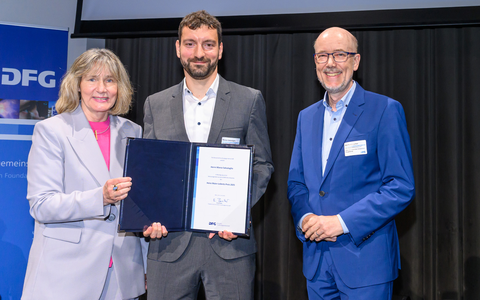Jun 03, 2025
TUD materials scientist receives prestigious Heinz Maier-Leibnitz Prize from the DFG

Der Preisträger Marco Salvalagio (mitte) mit der DFG-Generalsekretärin Heide Ahrens (links) und dem Laudator Kai Sundmacher (rechts).
The German Research Foundation (DFG) has awarded the prestigious 2025 Heinz Maier-Leibnitz Prize to Prof. Marco Salvalaglio from the Institute of Scientific Computing at TUD Dresden University of Technology. The prize is awarded for outstanding scientific achievements by researchers who are still in an early stage of their academic careers. Salvalaglio uses applied mathematics to investigate the behavior of materials and substances. In addition to Salvalaglio, the DFG bestowed this prize on nine other researchers. The prize is endowed with EUR 200,000.
"I feel extremely honored to receive this award. I see it not only as recognition of my work, but also of the achievements of my colleagues and students," says a delighted Salvalaglio. "The prize emphasizes the value of interdisciplinary research and promotes collaboration between disciplines, faculties and departments – an aspect that I believe is indispensable for scientific progress. The award is an additional incentive for me to direct my research into new scientific challenges."
Research at the interface of solid-state physics and applied mathematics
Salvalaglio works at TUD, specifically at the interface between solid-state physics, computational materials science and applied mathematics. His research focuses on the modeling and simulation of material properties. "In order to develop new and efficient materials, it is essential to understand their properties – from the atomic to the macroscopic scale – in other words, from the smallest building blocks of the material to its structure as a whole," explains Salvalaglio.
Based on the geometric arrangement of the atoms and molecules they contain, he investigates the behavior of materials and substances. The elastic and plastic behavior of metals is a particular focus of his work. He also formulates mathematical equations that allow him to model and efficiently simulate crystalline materials.
2025 Heinz Maier-Leibnitz Prize
This year, four female and six male researchers received the Heinz Maier-Leibnitz Prize – Germany’s most prestigious award for researchers in the early stages of their academic career. This was decided by the Joint Committee of the Deutsche Forschungsgemeinschaft (DFG, German Research Foundation) in Bonn. Each prizewinner received EUR 200,000, which they can use for further research work for over a period of up to three years. In addition, there is a programme allowance of 22 percent for indirect project costs. A total of 180 researchers from all scientific disciplines were nominated. The winners were selected by the committee responsible chaired by DFG Vice President and biochemist Prof. Peter H. Seeberger. The award ceremony was held on June 3 in Berlin.
About:
Prof. Marco Salvalaglio was an Alexander von Humboldt Fellow at TU Dresden and the Leibniz Institute for High Performance Microelectronics (IHP) from 2016 to 2018. He was appointed as a TUD Young Investigator in 2021. In the same year, he was promoted to Junior Research Group Leader as part of the DFG's Emmy Noether Programme. In 2024, he become an Extraordinary Professor for Computational Materials Science.
Information from the Research Information System (FIS) on Prof. Marco Salvalaglio
About the Heinz Maier-Leibnitz Prize:
The Heinz Maier-Leibnitz Prize is awarded annually to outstanding researchers who are at an early stage of their scientific careers. Since 1980, it has been named after the nuclear physicist and former DFG President Heinz Maier-Leibnitz and is regarded as the most important prize in Germany for promoting scientists at an early stage in their careers. The DFG and the Federal Ministry of Education and Research (BMBF) jointly awarded the prizes until 2022. Since 2023, the DFG has been awarding these prizes independently, and the prize money has been increased significantly from EUR 20,000 to 200,000 per prizewinner. The money can be used to fund scientific research for up to three years.
